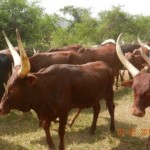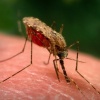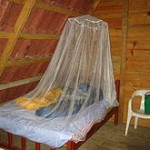
The use of livestock as bait to attract mosquitoes away from biting humans, and thus reduce malaria transmission, is an attractive proposition that has been mooted for many years. Animals would act as a dead-end host, as species of malaria that infect humans will not develop in them. This is a control strategy known as zooprophylaxis. Combined with the use of insecticide treated bednets (ITNs) that push mosquitoes out of houses and away from sleeping humans, livestock would add a pull component to enhance the control. However, the potential success of this “push/pull” strategy is unclear, and will depend on the local situation, and in particular, which mosquitoes species are the major vector in the area.
A paper on this topic that was recently published in in Parasites and Vectors, reports the results of a large scale study, conducted along the shores of Lake Victoria, Kenya. The study examined 1664 mosquito; collected by indoor spraying in 104 houses. Mosquitoes were monitored for the presence of sporozoites (the infective stage of the malaria parasite) and the source of their blood meal. In addition, human density in the houses, the use of insecticide treated bednets (ITNs), the presence of livestock tethered nearby and the position of larval breeding sites were determined.

Three species of anopheline mosquitoes are the major vectors of malaria in East Africa; Anopheles gambiae s.s. and Anopheles funestus s.s. are largely anthropophilic (feed preferentially on humans) and bite indoors, whereas Anopheles arabiensis is predominantly zoophagic, and bites outdoors. Since the use of ITNs, An arabiensis has become the most common malaria vector in the An. gambiae complex in the Lake Victoria basin of West Kenya.
There is year round transmission of malaria in the study area and approximately 40% of the population were found to have parasites, despite 82% of the study population sleeping under bednets. There was an average of 4.19 people sleeping in each house and cattle goats and sheep were tethered close to the houses at night.
Mosquitoes were examined for the presence of sporozoites, identified after extracting DNA from a leg. The source of their latest meal was identified using both PCR and ELISA (enzyme-linked immunosorbent assay) to detect blood from humans, cattle, dogs, sheep or goats. Roughly equal numbers of An. arabiensis and An. funestus were caught and far fewer An. gambiae. Cattle were the preferred host for An. arabiensis and significantly fewer fed on humans (12%) than the other two species (An. gambiae; 49.5% and An. funestus; 63.9%). Sporozoites were found in all three species, although the infection rate was significantly lower in An. arabiensis, the mosquito that fed more on cattle than humans. Because of the greater abundance of An. funestus, than An. gambiae, far more of this species contained sporozoites, making it the major vector in the area.

As the number of humans sleeping inside a house increased so did the number of mosquitoes caught there. An increase in the number of goats or sheep tethered nearby also increased mosquito numbers, though to a lesser extent. However, the use of ITNs halved the number of mosquitoes caught.
When the data were broken down into mosquito species, An. arabiensis was less affected by these factors than the other two species. The blood meal source also followed this pattern; with the overall proportion of mosquitoes feeding on humans increasing the more people were present in the house. However, although the presence of sheep and goats increased the number of An. arabiensis feeding on humans, the presence of cattle decrease it. This suggests that livestock are likely to attract An. arabiensis to human habitation, but if cattle are present they are more likely to feed upon the cattle than humans. The ephemeral larval breeding sites produced by cattle hoof prints also contributed to the overall picture, as their presence increased the likelihood of vector infection.
The authors conclude that in this area, where the use if ITNs has created a reduction in the population of An. gambiae, the presence of cattle could provide a zooprophylactic effect with respect to transmission by An. arabiensis but the presence of sheep or goats is associated with an increase in the abundance of mosquitoes and the likelihood of them feeding on humans. Furthermore, they note that use of ITNs as a push strategy overrode the negative effect of an increase in human density, and the nearby presence of goats and sheep. They recommend sheep and goats are tethered as far as possible away from houses.
The use of livestock as a prophylaxis is controversial. For example, a study in the 1990s found that the prevalence of malaria parasites in children of cattle-owning families in Pakistan was significantly greater than those from families with no cattle, thus cows provided no protection. A more recent study of a pastoralist community in Ethiopia found that the indoors catch of two mosquito vectors (An. arabiensis and Anopheles pharoensis) was nearly halved when there were cattle outdoors, but concluded that cattle would not act as an effective zooprophylaxis against malaria in this area as the number of infective bites per person per night was so high the reduction created by the pull of cows was not sufficient to reduce transmission.
The widespread use of ITNs has had a major impact upon the reduction in malaria transmission in East Africa and other countries. However concerns are now being raised about the reduced efficacy of these nets in areas where An. gambiae populations are now largely pyrethroid resistant. Additional problems may be the replacement of one vector population with another and reported shifts in biting behaviour of mosquitoes that will render ITNs less effective. Rather than relying entirely on a single method to reduce malaria transmission, combined strategies are essential. The latest study, highlighted here, suggests that, in specific locations with a preponderance of zoophilic mosquitoes, there may be some benefit gained from the presence of cows as an additional measure to reduce the incidence of disease, even though this ready source of blood meals could result in an increase in the population size of An. arabiensis. Whether the potential pull of cows translates into a lower incidence of malaria in households with cows in the vicinity would be a deciding factor.

Comments